Carolee Dean's Blog, page 8
June 10, 2023
So Many Amazing Children's Authors!
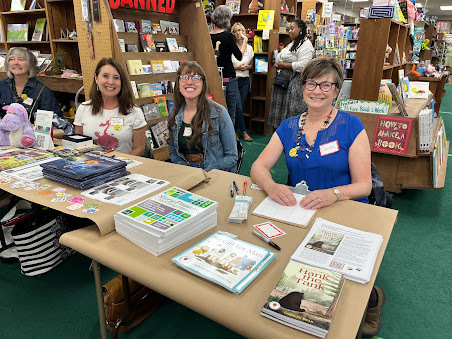
There were so many amazing authors (32 to be exact) at the event on Saturday, June 3, hosted by the Bookies Bookstore in Denver, CO, and the Rocky Mountain Branch of the Society of Children's Book Writers ad Illustrators (SCBWI). I sold all of the Hank the Tank books that I brought with me and was delighted to discover how many people have such a strong interest in decodable books. I am in the photo above on the far right. My two new friends, Christine Layton (middle) and Lauren H. Kerstein (third from the right), are at the same table. Lauren H. Kerstein is a social worker who writes books for children and young adults about social-emotional issues. Her new book, Home for A While, is about a boy in foster care finding a place that he can call home even if it's just for a while. I love social workers. They are some of my favorite people. Her book is important not only for kids living in any kind of transitional situation but also to help more advantaged children develop empathy and understanding.
Christine Layton is a brand new author who was at the bookstore with her debut book, Light Speaks. It is a picture book that reads like a poem while the back matter delves deeper into scientific concepts like how light waves travel through space and how we can still see stars today that died thousands of years ago. Christina has been an early childhood educator and is currently the Director of Adult Education at a public library in Colorado. You can tell from my book purchases below that I spent a fair amount of time shopping at this event.
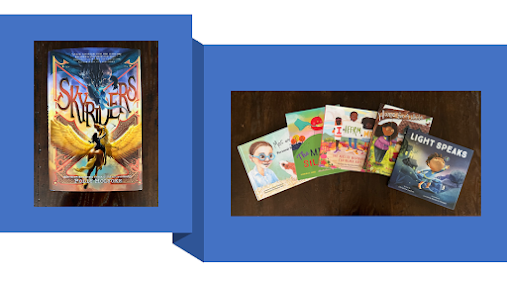
I also had the opportunity to connect with familiar faces. Jolene Gutierrez is on the right below with Mac and Cheese, a book about respecting personal space. She has a new book coming out in August entitled, Too Much. It's about sensory integration and kids who are sometimes overwhelmed by sensory stimuli. She will have two occupational therapists at her book launch on August 5 at Second Star on the Right to talk about how the book can be used with kids with sensory integration issues. You can get more information HERE. Jolene is a teacher and librarian who works with kids with learning challenges. We recently did a presentation, along with author Beth Anderson, for the Rocky Mountain Chapter of the International Dyslexia Association on "Using Narratives as a Bridge to Informational Text." Check out my interview with Jolene about her non-fiction book, Bionic Beasts.
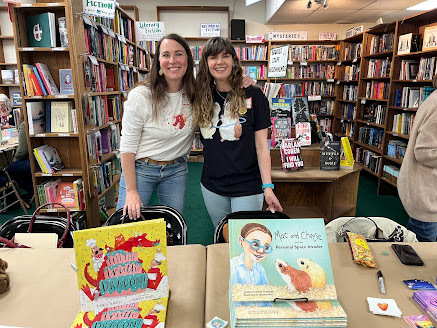
Below are some of the other authors I got to meet at the Bookies. I will be interviewing several authors over the next few months. Polly Holyhoke is the creator of the new middle-grade fantasy series, Skyriders. The main character is dyslexic, so you can be sure I will be talking about this book in October for Dyslexia Awareness Month. Kimberlee Gard is the author of The Mighty Silent e! I always love a book that plays with sound and spelling the way this book does. Finally, Nyasha Williams is the author of The ABC's of Inspiration for Black Kids. Her book offers many messages that are inspirational for all kids but that are especially important for kids who don't always see characters that look like them in picture books. My favorite message is, "I am my ancestors' wildest dreams." Nyasha's motto is, "Writing to Change the Narrative." I'm sure her ancestors are quite pleased with her success.
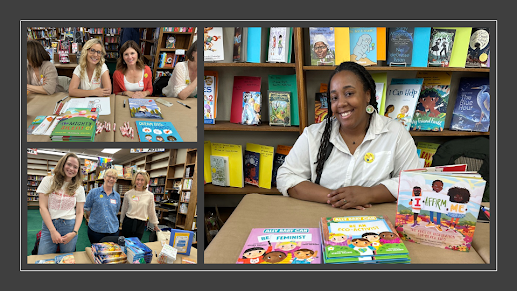
Support events like this one by shopping at local bookstores like THE BOOKIES and ordering books directly through the store. Any of the books mentioned here may be ordered through the The Bookies. Many are still on their shelves. They will be moving to a new location this fall at 2085 S. Holly Street in Glendale, CO. Their new building will have even more space for events and gatherings. Call them at 303-759-1117.
Keep up with upcoming author interviews and book news by signing up for my newsletter. Visit the Sign Up Page on my website at www.wordtravelpress.com for details and discover free offers. The website has several free downloadable activities including an activity guide for my new decodable book, Hank the Tank.
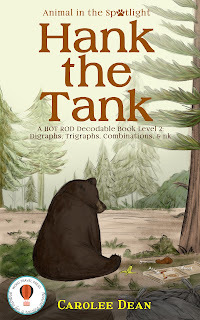
June 4, 2023
THE WORDS WE KEEP - YA Winner of the Schneider Family Book Award
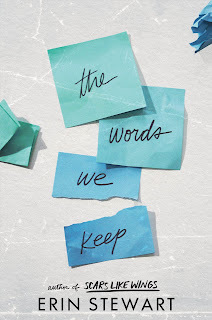
Keeping with this year's theme of resilience, this week I'm sharing two award-winning young adult books. The Words We Keep by Erin Stewart won the 2023 Schneider Family Book Award this year for the best teen title. This award showcases books that highlight the disability experience.
Lily embarks with a fellow student on a search to find poetry in unexpected places for a class project. In the process, she learns to use art and verse to deal with anxiety and depression.. The book speaks to anyone dealing with any sort of mental health challenge or any challenge at all. In addition to anxiety and depression, the story tackles bipolar disorder, self-harm, suicide, and OCD. Ultimately, through the voice of the protagonist, it lets teens know they are not alone in their struggles whatever those struggles might be.
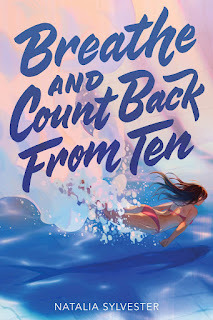
Breathe and Count Back from Ten, written by Natalia Sylvester, is a Schneider Family Teen Honor Title. It is also a Pura Belpre Honor Book. The latter award is given to Latina/Latino authors and illustrators. Like the author, the main character is a Peruvian-American who suffers from hip dysplasia. See the author interview at Publisher's Weekly where Natalia Sylvester talks about her own experiences with being an immigrant with hip dysplasia. The story is so personal, she could have written a memoir but decided to create a work of fiction instead. It's interesting to read her reasons for that choice. It helps us understand how much personal information can go into a work of fiction. It might be interesting for high school students to compare this book to the picture book memoir, Watercress by Andrea Wang which reflects on her experiences as a Chinese American.
In the novel, Breathe and Count Back from Ten, the main character, Veronica swims as a form of therapy. When she wants to become a "mermaid" at a local Florida attraction, she clashes with her traditional Peruvian parents. The book explores themes of immigration, body image, and disability justice. It also delves into mermaid mythology in a variety of cultures.
May 31, 2023
Denver Bookies Event
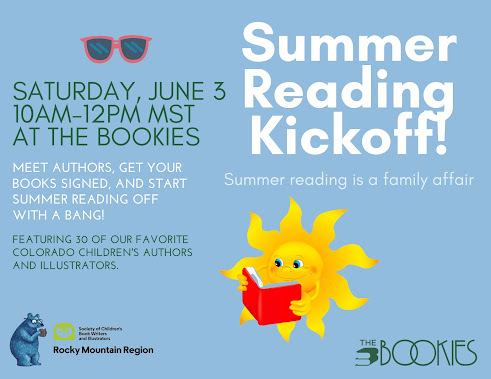
I will be at the Bookies this Saturday, June 3, with 29 other SCBWI Colorado Children's Authors to help kick off the bookstore's summer reading program. If you are in the Denver area, please stop by. The Bookies is located at 4315 E. Mississippi Ave, Denver, CO 80246.
I will be giving away a Free Activity Guide for Hank the Tank at the event. Hank the Tank is my new decodable book based on a real bear in the Lake Tahoe area. The Activity Guide includes a Scavenger Word Hunt based on Part 1 of the book which is also included as a preview. Other activities include a Snack Attack Word Mash Up. If you can't attend, don't worry. A link to the PDF will be available in my June newsletter. If you are not a newsletter subscriber, sign up HERE.
The Hank e-book is available now on Amazon. I will have a few preview copies of the paperback for sale at the bookstore. The paperback version will be available on Amazon in mid-June. I hope to see you there!!
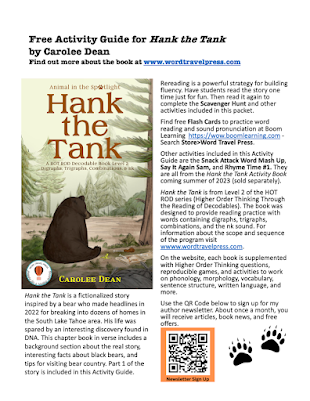
April 7, 2023
Resilience and English Language Learners

Recently I've been sharing stories of resilience. With that topic in mind, today I’m interviewing author, Beth Anderson, about her experiences as a teacher for English Language Learners. Beth and I will be serving on an author/educator panel along with Jolene Gutierrez for the annual Reading in the City Conference on April 15, 2023, in Denver, CO. The topic is “Using Narratives as a Bridge to Informational Text.” See last week's interview with Jolene.
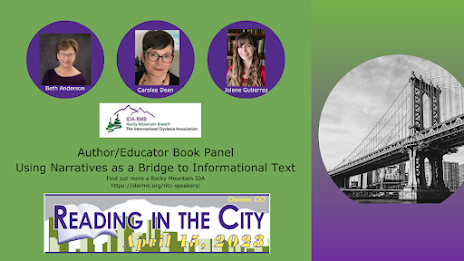
Carolee: You have written several narrative non-fiction picture books about real-life characters overcoming adversity. I’m sure that many of your students who were English Language Learners faced extreme adversity in their early lives. Did you find that certain stories resonated with them more than others?
Beth: Some of my students had dealt with things unimaginable to most Americans, but stories of real people facing challenges rang across culture, time, and place. True stories always opened up thinking as they inspired questions and connections. Most were stories of struggles, survival, life-changing choices, and trying to claim one’s place in the world. I think many immigrants and refugees have a stronger connection to these stories than many of us as they’ve lived these kinds of challenges. Not only do those stories connect to students, but they also have potential to contribute to the classroom community with shared understanding.
Carolee: Did you ever use picture books with teens? If so, what tips do you have for teachers who may want to use picture books with older readers?
Beth: I used picture books ALL THE TIME! Before we had an ESL curriculum, they were the springboard for content units that built language skills. Using the term “illustrated texts” can help with older kids who may be offended by “picture books.” I used them with high school English language learners and all the time with middle school kids. They were perfect for so many reasons: length, illustration support, rich language, embedded content, text/page, and more. I could teach all the language arts skills and also sneak in content support and academic vocabulary. Narrative nonfiction is dignified and inspiring for any age. Nothing “childish,” nothing that talks down. That’s the key. So my advice is to choose books that kids can relate to, that contain themes and characters suitable for maturing minds, and use high-quality art.
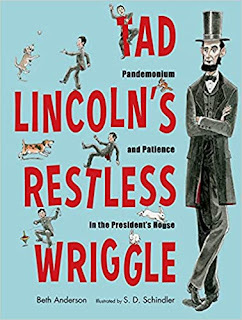
Carolee: In your book, Tad Lincoln’s Restless Wriggle, Tad had difficulty with reading as well as speaking. When a student is struggling to learn English as a second language, it may be difficult to tease out which ones may have speaking or reading challenges in their original language. Do you have any tips for identifying or working with these students?
Beth: Identifying learning issues and challenges is always extremely difficult for English language learners. While we don’t want to make hasty assumptions, we do want to get a student the support they need to be successful. It requires observing and taking notes as you try different approaches over an extended period of time. Learning as much as possible about their schooling history and past academic challenges through family interviews and any records you can obtain is helpful. Knowledge about their first language can shed light, too. The ability to test in the first language can be the only way to surmount some of the barriers, but not all school systems have that ability for every student.
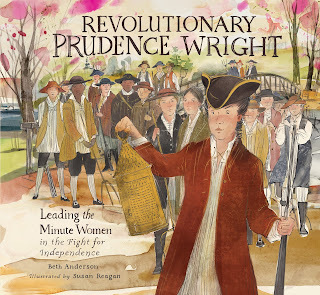
Carolee: One of the topics that you are planning to discuss during our panel is the Affective Filter. Can you tell us more about that topic and its implications for struggling learners?
Beth: The Affective Filter is a metaphor for how attitudes affect language acquisition. When cognitive overload and the inability to connect and create meaning from input result in frustration and failure, learning shuts down. The goal with ELLs is to scaffold and design instruction to make the classroom a learner-friendly environment where students can be successful. If you can lower the filter, learning happens. I think the affective filter is real for all students facing learning challenges. We all know how stress affects us—not only physically, but mentally and emotionally, too. The more support educators can provide to relieve classroom stresses and support struggling learners, the better chance they'll have to achieve and find their way in the world.Carolee: Thanks for your insights. I look forward to our panel next week!
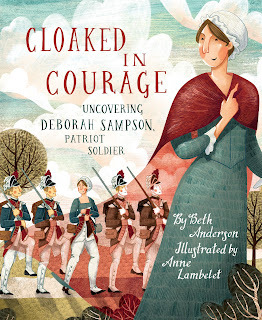
Find out more about our upcoming author/educator panel on "Using Narratives As a Bridge to Informational Text" HERE. Read the interview with co-panelist, Jolene Gutierrez, HERE.
Learn about Beth's latest book, Cloaked in Courage and explore last year's Q&A with Beth about Tad Lincoln's Restless Wriggle. Download the free activity guide.
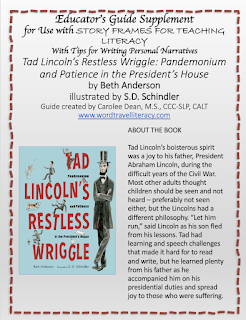
Keep up with my book reviews and discover more exciting stories of resilience by signing up for my newsletter. Visit the Sign Up Page on my website at www.wordtravelpress.com for details and discover free offers. Check out the first book in my new decodable book series - No Gift for Man. It is available for FREE as an e-book if you have a Kindle Unlimited account, or it can be purchased as either an e-book or paperback.
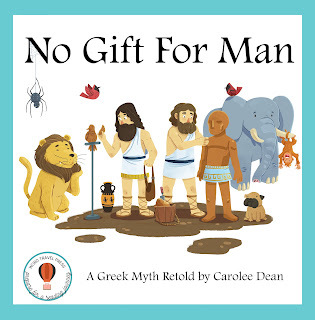
March 31, 2023
The Resilience of BIONIC BEASTS: Q&A with Author Jolene Gutierrez
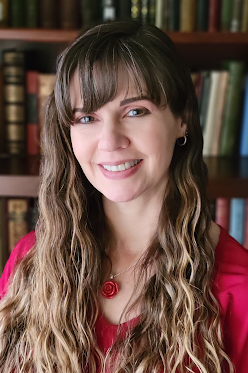
Today I’m interviewing author, Jolene Gutierrez, about her experiences working as a teacher and librarian for diverse learners. Jolene and I will be serving on an author/educator panel along with Beth Anderson for the annual Reading in the City Conference on April 15, 2023, in Denver, CO. The topic is on “Using Narratives as a Bridge to Informational Text.” Since the theme of this year's blog is resilience, I wanted to ask her some questions about her experiences as an educator as well as her new book, Bionic Beasts: Saving Animal Lives with Artificial Flippers, Legs, ad Beaks
Carolee: I have been sharing your book, Bionic Beasts, with my students with dyslexia. They love the stories of animals with physical disabilities overcoming challenges by using prosthetic legs, fins, and beaks. Your title, BIONIC Beasts, not only normalizes the use of prosthetics (or any aids for that matter), but it even makes these animals sound a bit like superheroes. In your work with struggling students, how have you seen stories help them to develop a growth mindset?
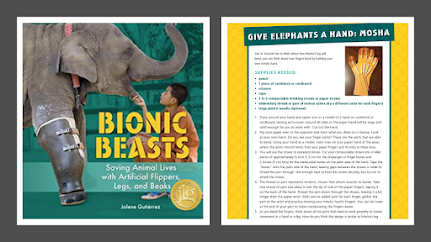
One of the biggest gifts books give us is the ability to broaden our world by learning about others’ experiences–stories help students become more compassionate and open to others’ viewpoints. Many of my students have connected with characters who have had challenges in their lives. I think it’s comforting to know that you’re not alone in your struggles, and books help young readers to see that.
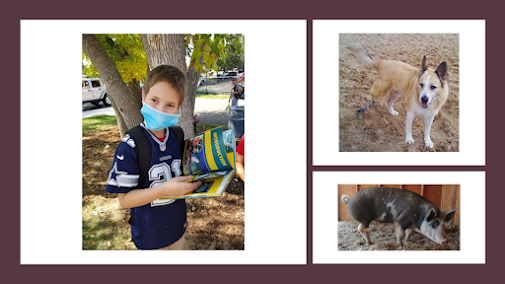
Carolee: Stories of resilience are so important to kids with learning challenges. I’m sure that in your role as a librarian, you have had the opportunity to connect readers to books that help them see real-life or even fictional examples of resilience. Are there any particular titles that you recommend?
Jolene: Learning differences don’t figure into most of the author Avi’s characters, but Avi has a long history with our school and has spoken candidly with our students about his own learning challenges. It’s inspiring for our students to have a personal connection to an author who has become so successful despite his struggles in school. We’ve also had visits with Henry Winkler and Patricia Polacco, both of whom spoke about how dyslexia impacted their lives. Because of these author visits, our kids love the Hank Zipzer and Here’s Hank! series as well as Polacco’s picture books. For more in the realm of books written by people who have experienced challenges themselves, we love Elana K. Arnold’s A Boy Called Bat trilogy, Leslie Connor’s books, Cece Bell’s graphic novel El Deafo, and Raina Telgemeier’s graphic novel Guts.
Carolee: In your Bionic Beasts chapter about Lola, the Sea turtle, I was struck by how depressed she seemed to get when she couldn’t swim without bumping into the side of her tank. She basically gave up and sat at the bottom waiting for food. Then when she received her prosthetic fin, she made a complete turnaround and swam all the time. What do you think animal emotions can teach kids about their own emotions?
 Jolene on the farm
Jolene on the farmJolene: I think understanding that humans aren’t the only creatures who experience emotions will help kids to better understand their larger connection to the world and, again, this is a chance for them to practice compassion. I grew up as a farm kid in a very small community, and even though I was surrounded by animals my entire life, books like Charlotte’s Web by E.B. White and A Horse Called Dragon by Lynn Hall helped me become a more thoughtful human being. In my personal and professional experience, many kids love nature, science, and animals, and sometimes, they connect with animal stories more deeply than stories with human characters.
Carolee: Thanks for your insights. Check out our upcoming panel HERE. Check out more of Jolene’s books at https://www.jolenegutierrez.com/.
Keep up with book reviews and stories of resilience by signing up for my newsletter. Visit the Sign Up Page on my website at www.wordtravelpress.com for details and discover free offers.
March 23, 2023
Wildoak - Middle-Grade Winner of the Schneider Family Book Award
The 2023 Schneider Family Book Awards were given out in January. The award honors an author or illustrator for "... the artistic expression of the disability experience for child and adolescent audiences." This week I'm sharing the 2023 middle-grade award winner, Wildoak, written by C.C. Harrington.
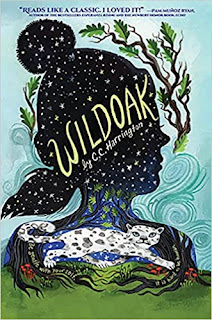
Maggie Stephens goes to stay with her grandfather in the country. Her parents hope that some time in Wildoak Forest will improve her stuttering. While Maggie is there she finds a snow leopard cub that had been purchased as a gift and then abandoned. It is set in 1963 when a wild cat like a snow leopard could actually be purchased at Harrods in London from the exotic pet department that they called Pet Kingdom. Fortunately, that ended in 1976 with the Endangered Species Act.
Although Maggie stutters when she speaks to humans, she is able to speak quite clearly to animals. The story is about communication on many different levels. Even the forest has a voice. It is ultimately a story about compassion and understanding. This is author C.C. Harrington's debut novel. She has experience teaching students with learning differences. Perhaps that is what makes her so empathetic to people who are different. One of the most poignant quotes is, "... there's room in this beautiful, complicated world of ours for all of us. Just as we are. In fact, there is a need for it."
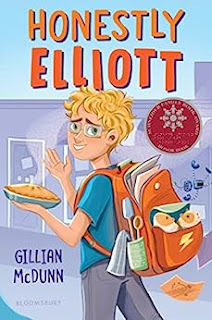
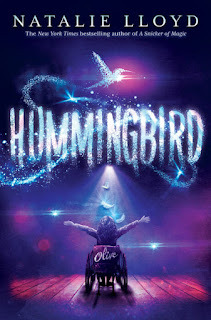
Middle-Grade Honor Titles included Honestly Elliott by Gillian Dunn and Hummingbird by Natalie Lloyd. Honestly Elliott is a story of a boy starting middle school who struggles with ADHD while Hummingbird features a twelve-year-old girl who uses a wheelchair due to brittle bone disease.
For more stories of resilience, check out these books:
Listen: How Evelyn Glennie, a Deaf Girl, Changed Percussion written by Shannon Stocker and illustrated by Devon Holzwarth
It's My Whole Life: Charlotte Salomon: An Artist in Hiding During World War II by Susan Wider
Jubilee: The First Therapy Horse and an Olympic Dream written by KT Johnston and illustrated by Anabella Ortiz.
Keep up with my book reviews on more exciting stories of resilience by signing up for my newsletter. Visit the Sign Up Page on my website at www.wordtravelpress.com for details and discover free offers.
March 20, 2023
Using Narratives As a Bridge to Informational Text
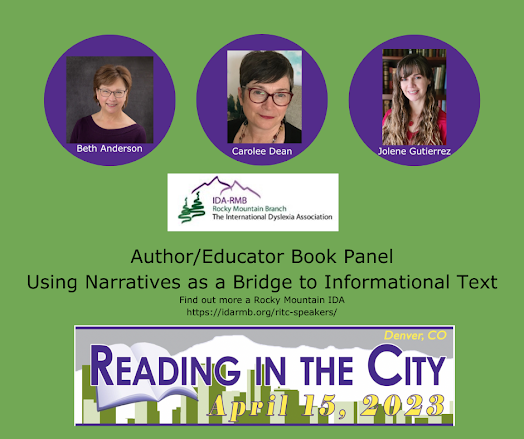
I'm thrilled to announce that I will be presenting on an author panel with Beth Anderson and Jolene Gutierrez at Denver Academy for the annual Reading in the City Conference on April 15, 2023. The subject is "Using Narratives As a Bridge to Informational Text."
Many students struggle with understanding story structure. Even those who do have a good understanding of narrative text still have difficulty making the leap to understanding informational text.
Narratives and Informational Texts actually have a lot in common, especially when those narratives are based on the type of real-life heroes and celebrities that Beth and Jolene write about in their books. Some of those characters are even animals! Narrative non-fiction picture books, biographies, personal interest stories, and scientific innovations told from the perspective of the characters who experience them can all be used to help students form a bridge between narratives and non-fiction.
Watch my blog in April for Q&As with these two amazing authors and learn more about their books. I will also be sharing tips for comparing narratives and informational pieces from my book, Story Frames for Teaching Literacy.
These women are not just successful authors. They are also educators. Beth is a retired ELL teacher who spent many years teaching English Language Learners. Jolene works with students with learning challenges as both a teacher and librarian.
The regular registration price for the conference is in effect through March 30. Find out more information at https://idarmb.org/ritc-speakers/.
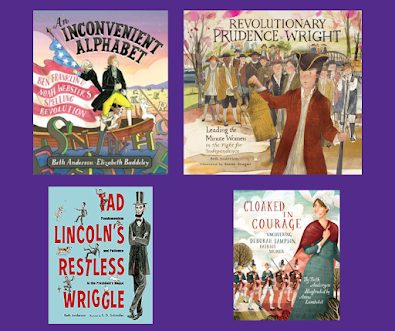

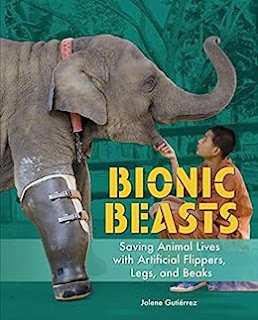
Keep up with book reviews and stories of resilience by signing up for my newsletter. Visit the Sign Up Page on my website at www.wordtravelpress.com for details and discover free offers.
February 27, 2023
My First Decodable Book
I'm thrilled to announce that my first decodable book, No Gift for Man, is available as an e-book. In fact, you can get it for FREE on Kindle Unlimited. If you do get the book, PLEASE leave a review on amazon! Reviews are what drive ratings and that is what gets books recognized by other readers. This book is useful for teachers and tutors of students with dyslexia, and also parents and grandparents who are looking for books to share with developing readers.
The story aligns with Level 1 of my Hot Rod Scope and Sequence and focuses on closed/short vowel sounds. The Pair and Share Reading Strategy is used to give background information about the Greek Creation Myth.
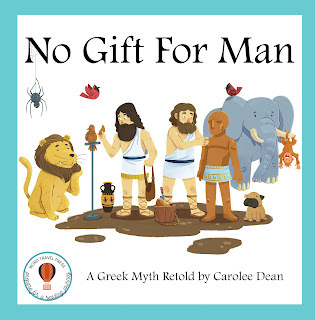
Visit my website at Word Travel Press to find supplementary games and activities as well as information about the Scope and Sequence of the series. There are several free sample games on my page for COR Instruction. Watch for news about the paperback version and additional books coming soon. The colorful illustrations in this book make it engaging for kids of all ages, but if you would prefer a text-only version for teens, you can get a free PDF of the text when you sign up for my newsletter. Visit the Sign Up Page on my website at www.wordtravelpress.com for details.
February 7, 2023
LISTEN and IN THE BLUE- Award Winning Picture Books Exploring the Disability Experience
Continuing with my theme for 2023 of sharing stories about perseverance, today I'm looking at award winning picture books exploring the disability experience.
Every January the American Library Association (ALA) announces its most prestigious awards at its Midwinter Conference. These include the Caldecott, the Newbery, and the Printz Medals. In addition, there are several lesser known categories of winners that appeal to specific interest groups. One of these is the Schneider Family Book Award which honors an author or illustrator for "... the artistic expression of the disability experience for child and adolescent audiences." There are three categories for ages 0-8, 9-13, and 14-18.
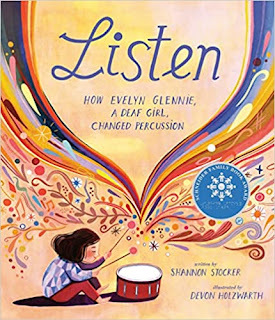
The 2023 winner of the Young Children's (0-8) category was Listen: How Evelyn Glennie, A Deaf Girl, Changed Percussion written by Shannon Stocker and illustrated by Devon Holzwarth.
Evelyn loved music from a very young age. When she was eight, she could play songs on the piano by ear. At ten she tackled the clarinet. But soon she began to lose her hearing. A doctor told the family that the nerves in Evelyn's ears were degenerating. By the time she was eleven, she could barely hear the phone ring, but there was something she could hear - percussion. She loved the marimba, the timpani, and the snare drum and she found an understanding music teacher who helped her learn how to "feel" the different sounds in her body. She went on to attend the Royal Academy of Music and become an award-winning solo percussionist. To this day she performs barefoot so that she can feel the musical vibrations as they move through the floor and into her feet.
As a speech-language pathologist, I especially enjoyed the explanation of how sound and touch are similar. Air vibrates and travels through the human ear before that vibration is converted into an electrical signal that we perceive as sound.
Evelyn was featured in a BBC documentary called, The Will to Win and a second documentary called Good Vibrations. She has created a film entitled Touch the Sound and the TED Talk, "How to Truly Listen." She has a solo album entitled Rhythm Song and more than 40 CDs.
Read more about Evelyn at www.evelyn.co.uk. Check out her website where you will find videos of her discussing "Feeling Sound" and other topics. You can also listen to samples of her music.
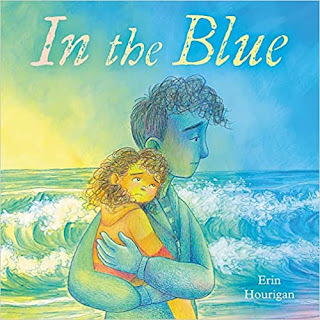
The 2023 honor title for Young Children was In the Blue written and illustrated by Erin Hourigan. It is a picture book for young children (ages 4-8) about depression that handles a sensitive topic and makes it accessible through the use of art and color. The book provides a sensitive and thoughtful way to begin conversations with young children about mental illness.
For more stories of resilience, check out my January 28th post on It's My Whole Life: Charlotte Salomon: An Artist in Hiding During World War II by Susan Wider as well as Jubilee: The First Therapy Horse and an Olympic Dream written by KT Johnston and illustrated by Anabella Ortiz.
Keep up with my book reviews on more exciting stories of resilience by signing up for my newsletter. Visit the Sign Up Page on my website at www.wordtravelpress.com for details and discover free offers.
LISTEN - An Award Winning Picture Book Exploring the Disability Experience
Continuing with my theme for 2023 of sharing stories about perseverance, today I'm looking at award winning picture books exploring the disability experience.
Every January the American Library Association (ALA) announces its most prestigious awards at its Midwinter Conference. These include the Caldecott, the Newbery, and the Printz Medals. In addition, there are several lesser known categories of winners that appeal to specific interest groups. One of these is the Schneider Family Book Award which honors an author or illustrator for "... the artistic expression of the disability experience for child and adolescent audiences." There are three categories for ages 0-8, 9-13, and 14-18.

The 2023 winner of the Young Children's (0-8) category was Listen: How Evelyn Glennie, A Deaf Girl, Changed Percussion written by Shannon Stocker and illustrated by Devon Holzwarth.
Evelyn loved music from a very young age. When she was eight, she could play songs on the piano by ear. At ten she tackled the clarinet. But soon she began to lose her hearing. A doctor told the family that the nerves in Evelyn's ears were degenerating. By the time she was eleven, she could barely hear the phone ring, but there was something she could hear - percussion. She loved the marimba, the timpani, and the snare drum and she found an understanding music teacher who helped her learn how to "feel" the different sounds in her body. She went on to attend the Royal Academy of Music and become an award-winning solo percussionist. To this day she performs barefoot so that she can feel the musical vibrations as they move through the floor and into her feet.
As a speech-language pathologist, I especially enjoyed the explanation of how sound and touch are similar. Air vibrates and travels through the human ear before that vibration is converted into an electrical signal that we perceive as sound.
Evelyn was featured in a BBC documentary called, The Will to Win and a second documentary called Good Vibrations. She has created a film entitled Touch the Sound and the TED Talk, "How to Truly Listen." She has a solo album entitled Rhythm Song and more than 40 CDs.
Read more about Evelyn at www.evelyn.co.uk. Check out her website where you will find videos of her discussing "Feeling Sound" and other topics. You can also listen to samples of her music.

The 2023 honor title for Young Children was In the Blue written and illustrated by Erin Hourigan. It is a picture book for young children (ages 4-8) about depression that handles a sensitive topic and makes it accessible through the use of art and color. The book provides a sensitive and thoughtful way to begin conversations with young children about mental illness.
For more stories of resilience, check out my January 28th post on It's My Whole Life: Charlotte Salomon: An Artist in Hiding During World War II by Susan Wider as well as Jubilee: The First Therapy Horse and an Olympic Dream written by KT Johnston and illustrated by Anabella Ortiz.
Keep up with my book reviews on more exciting stories of resilience by signing up for my newsletter. Visit the Sign Up Page on my website at www.wordtravelpress.com for details and discover free offers.



